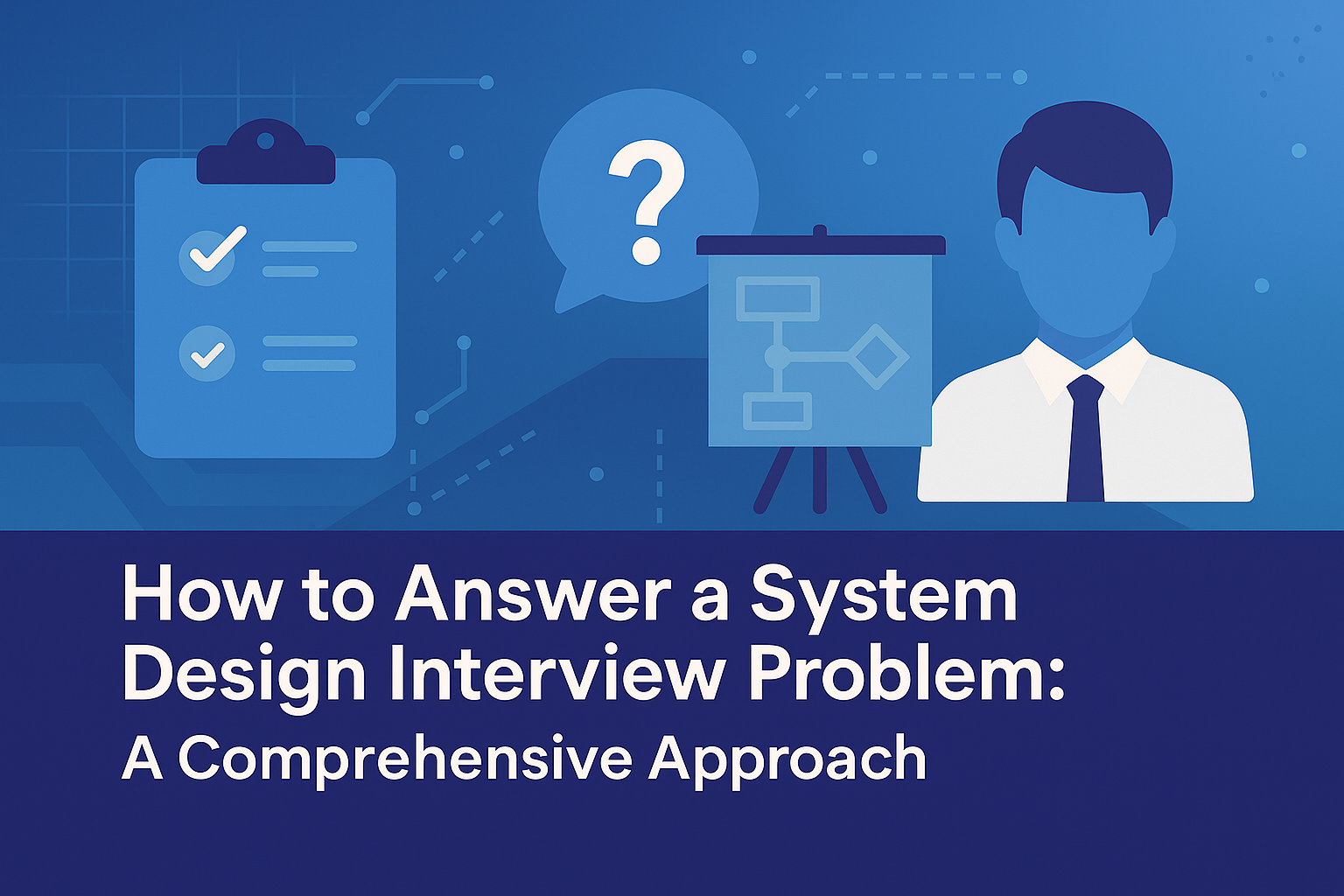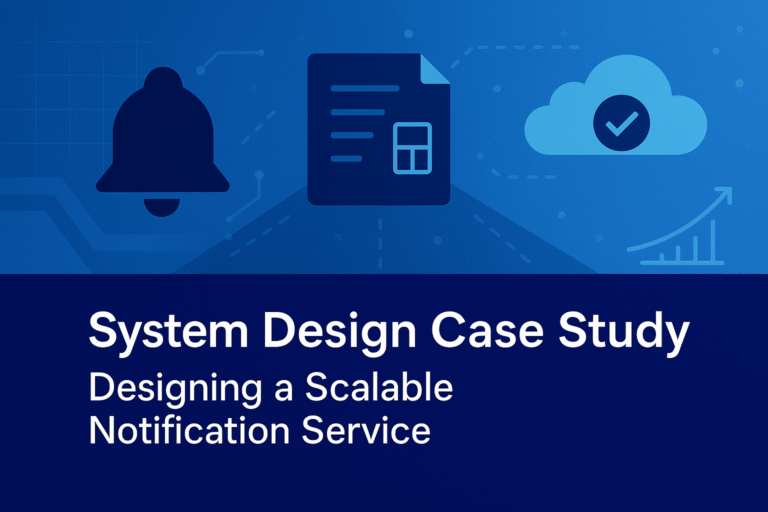Concept Explanation
Answering a system design interview problem demands a systematic and structured methodology to effectively demonstrate an understanding of architectural principles, trade-offs, scalability considerations, and practical implementation strategies. System design interviews are designed to assess a candidate’s capability to architect scalable, reliable, and efficient systems tailored to real-world scenarios, such as designing a URL shortener, a social media platform, a ride-sharing service, or a distributed file storage system. The primary objective is to exhibit clarity, logical reasoning, and a comprehensive approach by dissecting the problem into manageable components while addressing both functional requirements (e.g., user registration, content posting, route calculation) and non-functional requirements (e.g., latency under 200 milliseconds, 99.99% uptime, handling 1 million concurrent users).
The recommended approach follows a multi-step framework: clarifying the problem, defining a high-level design, detailing the component architecture, discussing trade-offs, and addressing edge cases and scalability concerns. This structured process ensures a coherent narrative, highlighting analytical prowess, problem-solving skills, and the ability to communicate complex ideas effectively to interviewers—key traits sought by leading technology firms such as Google, Amazon, Microsoft, and Netflix.
- Clarification: This initial step involves engaging with the interviewer to refine the problem scope by posing targeted questions. Examples include determining the expected user base (e.g., 100,000 daily active users or 10 million), performance targets (e.g., latency < 100ms), availability goals (e.g., 99.95%), data volume (e.g., terabytes of user data), and specific features or constraints (e.g., real-time updates, offline support). This step prevents assumptions and aligns the solution with the problem’s context.
- High-Level Design: This phase outlines the system’s major components, such as frontend interfaces, backend services, databases, caching layers, message queues, and external integrations (e.g., payment gateways, mapping services). The goal is to provide a bird’s-eye view of the architecture, establishing the flow of data and control.
- Detailed Design: Here, the focus shifts to specifying individual components, including API endpoints (e.g., /api/v1/users/register), data models (e.g., User {id, name, location}), algorithms (e.g., nearest neighbor search), and technologies (e.g., Redis for caching). This step demonstrates technical depth and practical implementation knowledge.
- Trade-Offs: This involves evaluating design alternatives, such as choosing between relational (SQL) and non-relational (NoSQL) databases, or between vertical and horizontal scaling. It requires justifying decisions based on performance, cost, and scalability, acknowledging inherent compromises.
- Edge Cases and Scalability: This final step addresses potential failure modes (e.g., server outages, network partitions), peak load scenarios (e.g., Black Friday traffic surges), and optimization strategies (e.g., load balancing, sharding). It underscores resilience and foresight in design.
This framework aligns with industry standards, emphasizing holistic system thinking over granular coding, and is adaptable to various problem domains, from microservices to monolithic architectures. It also reflects the iterative nature of real-world system design, where feedback loops refine the solution.
Real-World Example: Designing a Ride-Sharing Service like Uber
To exemplify this approach, consider the system design problem: “Design a ride-sharing service like Uber.” This scenario involves multiple functionalities—user registration, ride requests, driver matching, real-time tracking, fare calculation, payment processing, and customer support—making it an ideal candidate for demonstrating the framework.
- Clarification: Begin by engaging the interviewer with questions to define scope. Ask about the target user base (e.g., 1 million daily active users), geographic coverage (e.g., 50 cities), performance requirements (e.g., < 5-second matching latency, < 2-second tracking updates), availability targets (e.g., 99.9% uptime), and specific features (e.g., surge pricing, offline mode). Assume a moderate scale of 1 million users, 5-second latency, and 99.9% availability for this example, unless otherwise specified.
- High-Level Design: Sketch a high-level architecture comprising:
- Clients: Mobile apps (iOS/Android) and a web portal for users and drivers, built with React Native for cross-platform compatibility.
- Backend Services: Microservices for user management, ride matching, real-time tracking, fare calculation, and payment processing, deployed on a cloud platform like AWS.
- Databases: A relational database (e.g., PostgreSQL) for user profiles and trip history, and a NoSQL database (e.g., MongoDB) for real-time data like driver locations.
- Message Queues: Apache Kafka for handling asynchronous events, such as location updates or payment confirmations.
- External Integrations: Google Maps API for geolocation and Stripe for payments.
- Load Balancers and CDNs: To distribute traffic and cache static content. This design establishes data flow: users request rides via the app, the matching service queries driver locations, and responses are streamed back in real time.
- Detailed Design: Specify components in depth:
- API Endpoints: RESTful APIs like /api/v1/rides/request (POST with pickup/drop-off coordinates) and /api/v1/rides/track (GET with ride ID).
- Data Models: User {id, name, email, rating}, Driver {id, location, status}, Ride {id, user_id, driver_id, status, fare}.
- Matching Algorithm: Use a geospatial index (e.g., Redis Geo) to find the nearest drivers within a 5 km radius, sorted by ETA.
- Tracking: WebSocket connections for real-time updates, with a fallback to polling if connectivity drops.
- Technologies: Node.js for backend logic, Redis for caching driver locations, and Kafka for event streaming.
- Trade-Offs: Evaluate design choices:
- Horizontal vs. Vertical Scaling: Horizontal scaling across multiple servers enhances throughput for 1 million users but increases complexity (e.g., data synchronization). Vertical scaling on a single powerful server simplifies management but limits scalability beyond hardware constraints.
- SQL vs. NoSQL: PostgreSQL ensures strong consistency for payments but may lag in real-time queries; MongoDB offers flexibility for location data but sacrifices consistency.
- Synchronous vs. Asynchronous: Synchronous APIs ensure immediate responses but block under load; asynchronous processing with Kafka improves throughput but introduces latency.
- Edge Cases and Scalability: Address scenarios:
- Peak Load: During rush hours (e.g., 6 PM IST on September 25, 2025), auto-scale servers using AWS Auto Scaling, targeting 10,000 requests/second.
- Network Partitions: Implement eventual consistency for tracking, with a 5-second reconciliation window.
- Offline Mode: Cache recent ride data locally on the app, syncing when online.
- Surge Pricing: Dynamically adjust fares based on demand-supply ratios, with a cap to avoid user backlash.
Implementation Considerations for Designing a Ride-Sharing Service like Uber
- Clarification: Engage the interviewer further by refining assumptions. Query about peak usage (e.g., 10 million users during New Year’s Eve), latency constraints (e.g., < 3 seconds for matching), and additional features (e.g., carpooling, multi-language support). Assume a global scale of 10 million users, < 3-second latency, and 99.95% availability for robustness.
- High-Level Design: Expand the architecture:
- Clients: Develop with React Native, integrating Google Maps SDK for geolocation, and support offline caching with IndexedDB.
- Backend Services: Deploy microservices using Docker containers on Kubernetes, with services for authentication (Keycloak), matching (geospatial queries), tracking (WebSocket server), and payments (Stripe integration).
- Databases: Use PostgreSQL for transactional data (e.g., user accounts, payments) with replication for high availability, and Cassandra for real-time location data with sharding.
- Message Queues: Implement Kafka with Zookeeper for event ordering, handling 1 million events/hour.
- Caching: Deploy Redis for in-memory storage of driver locations, reducing query latency to < 50ms.
- Load Balancers: Use NGINX with health checks to distribute traffic across regions.
- Detailed Design: Specify implementation:
- API Design: Define Swagger-documented endpoints, e.g., /api/v1/rides/match (POST {pickup: [lat, lng], dropoff: [lat, lng]}) returning {driver_id, eta}.
- Matching Logic: Use Haversine formula for distance calculation, optimized with Redis GeoRadius, returning top 5 drivers.
- Tracking: Establish WebSocket channels per ride, with a fallback HTTP polling mechanism every 5 seconds.
- Security: Implement JWT for authentication, rate limiting at 100 requests/minute per user, and HTTPS for data encryption.
- Monitoring: Use Prometheus for metrics (e.g., latency p99 < 3s, throughput 10k req/s) and Grafana for dashboards.
- Deployment: Utilize CI/CD pipelines with Jenkins, testing with JMeter for 1 million concurrent users, and deploy across AWS regions (e.g., US-East, EU-West) for latency optimization.
- Maintenance: Schedule updates during low-traffic windows (e.g., 2 AM IST) and perform failover tests quarterly.
Trade-Offs and Strategic Decisions in Designing a Ride-Sharing Service like Uber
- Latency vs. Throughput: The matching service optimizes for low latency (< 3 seconds) by caching driver locations in Redis, but batching requests during peaks (e.g., 10k req/s) increases throughput at the cost of a 1-second latency spike. This trade-off prioritizes user experience during normal operation, with batching activated only under load.
- Consistency vs. Performance: Real-time tracking uses eventual consistency, allowing a 5-second lag in location updates to achieve high performance (e.g., 10k updates/s), while payment processing enforces strong consistency with two-phase commits, accepting a 20% performance hit to ensure financial accuracy.
- Cost vs. Scalability: Horizontal scaling with additional servers increases operational costs (e.g., $10k/month for 100 instances) but supports 10 million users, whereas vertical scaling on a single $5k server limits growth but reduces initial expense. The decision favors horizontal scaling, aligning with Uber’s global reach.
- Monolith vs. Microservices: A monolithic approach simplifies early development but hinders scalability; microservices enhance modularity (e.g., separate matching and payment services) but introduce inter-service communication overhead (e.g., 10ms latency). Microservices are chosen for long-term flexibility.
- Strategic Decisions: Prioritize horizontal scaling with auto-scaling policies (e.g., add 5 nodes if CPU > 80% for 5 minutes), implement geo-distributed databases for latency (e.g., < 100ms cross-region), and use event-driven architecture with Kafka for resilience. Start with a minimal viable product (MVP) for 100k users, iterating based on metrics like MTTR (< 5 minutes) and SLA adherence (99.95%).
Conclusion
This elaborated framework provides a detailed, structured approach to tackling system design interview problems, exemplified by designing a ride-sharing service like Uber. By clarifying requirements, designing holistically, detailing components, evaluating trade-offs, and addressing edge cases, candidates can demonstrate expertise and adaptability. This method ensures alignment with real-world engineering practices, preparing individuals for success in technical interviews.




